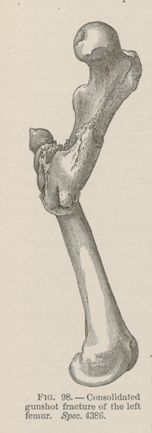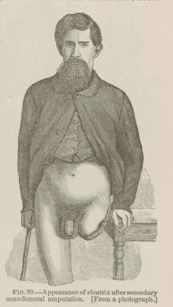Title: Lemon, George W.
Source text: The Medical and Surgical History of the War of the Rebellion. (1861-65.), Part 3, Volume 2 (Washington, DC: Government Printing Office, 1883), 145.
Civil War Washington ID: med.d2e6545
TEI/XML: med.d2e6545.xml
CASE 320.—Private George W. Lemon, Co. C, 6th Maryland, aged 30 years, had his left femur fractured, at the junction of the middle and upper thirds, by a conoidal musket ball, at the battle of the Wilderness, May 5, 1864. He was left in a shelter tent on the field and fell into the hands of the enemy. On May 13th he was recaptured, and was sent to Fredericksburg, and thence to Alexandria, where he was received at the Third Division Hospital on June 14th. When admitted he had diarrhœa and was greatly emaciated. There was a bed-sore, four inches in diameter, over the sacrum, and smaller sores over the prominences on the spine and scapulæ. The lower end of the upper fragment of the femur protruded from the wound, from which there was a profuse offensive ash-colored discharge. To check the diarrhœa, to administer suitable nourishment, and to take pressure from the bed-sores by supporting the body on air cushions, were the first matters attended to. Then moderate extension was applied to the injured limb, and a tolerably good position was maintained by means of pillows and cushions. In three weeks the bed-sores were healed, and there was a slight improvement in the general constitutional condition. Extension of the limb causing pain, it was discontinued. For the next ten or twelve months the patient clung to life by the slenderest thread. Detached fragments of bone frequently gave rise to inflammatory swelling, abscesses in the thigh, and profuse suppuration. Yet the appetite and digestion continued to be good, and the great drain upon the system was supported unusually well. In May, 1865, it was found that the fracture was quite firmly consolidated. The patient now occasionally sat up in a chair, but every attempt of the sort was followed by acute inflammation of the thigh, with increased suppuration. It was now decided that the patient must ultimately sink under the profuse suppuration, and that an operation should be performed as soon as it was opportune, and that every effort should be made to put the patient in a condition to support this shock. On October 12, 1865, Surgeon Edwin Bentley, U. S. V., proceeded to amputate at the hip joint. Chloroform was administered; the external iliac artery was compressed at the pubis; anterior and posterior semilunar flaps were formed by transfixion, and the femur was disarticulated. The hæmorrhage was inconsiderable, and the patient reacted soon and satisfactorily. From the day of the operation he steadily improved, with scarcely an untoward symptom. On November 15th, Dr. Bentley reported that the ligatures had all come away, and that the wound was granulating kindly. In December the stump was healed, and the patient began to get about on crutches. The fracture of the exarticulated femur was found to be imperfectly but quite firmly united, with great antero-posterior angular deformity and shortening. The bone was sent to the Army Medical Museum, where it is preserved as Specimen 4386. A posterior view of it is given by the annexed left hand wood-cut (FIG. 98). On January 31, 1866, a photograph of the man was taken, from which the right hand wood-cut (FIG. 99) is copied. Lemon was then transferred to the Harewood Hospital, at Washington. He was then quite well, and able to go where he chose on crutches. The cicatrix was firm and healthy. On February 3, 1866, he was discharged from the hospital, and from the service of the United States, at his own request. He went to his home at Bird Hill, Carroll county, Maryland, and resumed his trade of shoemaking. He was granted a pension of fifteen dollars a month. On April 23, 1867, a letter was received from him in which he stated that his health was excellent; that he weighed ninety-nine and a half pounds, an increase of twelve and a half pounds from the date at which he left the hospital; and that he had been able to walk to the village of Westminster, a distance of seven miles, without fatigue. In a letter dated Westminster, Maryland, July 31, 1870, he states "that the artificial limb is not now or ever has been of the least service to me. * * I have tried to wear it; but it only serves to irritate the stump, and makes it so raw and sore that I cannot bear it to touch anything for days afterwards." The pensioner was paid June 4, 1878.¹
¹ This secondary amputation at the hip is noted on page 52 of Circular No. 6, S. G. O., 1865, in a foot-note. In the Catalogue of the Surgical Section of the Army Medical Museum, of 1866, p. 248, there is a brief memorandum of the facts of the case, with a wood-cut of the fractured femur, contributed to the Museum by the operator, Surgeon EDWIN BENTLEY, U. S. V. A detailed account of the case, compiled from the reports of the Third Division Hospital, Alexandria, and Harewood Hospital, Washington, is printed in Circular No. 7, S. G. O., 1867, p. 42.

